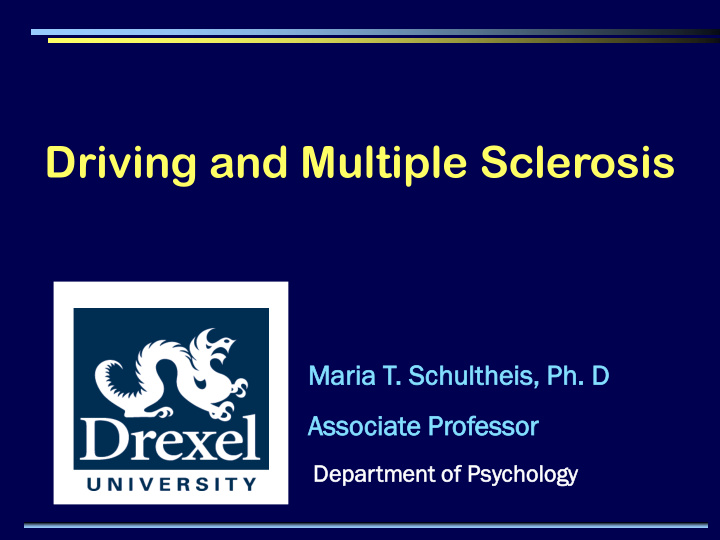



Driving and Multiple Sclerosis Mar aria ia T. . Schultheis eis, Ph Ph. D . D Associate P Professor Depa partment o of Psy Psychology
Applied Neurotech Lab”s approach …..applied and focuses on functional everyday activities relevant to overall quality of life Driving, return to work, decision-making, etc., ….. is interdisciplinary Neurologists, information technology, engineers, rehabilitation specialist, driver specialist, family ……is scientist-practitioner Goal is to take the science from the lab to the clinic
Activities of Daily Living (ADL) Often addressed in rehabilitation Many ways for define this term Basic ADL Functional ADL Can be affected by Physical Behavioral/emotional cognitive
“Driving is one of the most complex activities of daily living”
Driving after neurological compromise Physical Cognitive ? Behavior Road Knowledge
The severity factor ? MILD MODERATE SEVERE
Multiple Sclerosis Young adults (30-40) Vocational and social disruption Progressive disease Presents with combination of physical, cognitive and emotional impairments
Multiple Sclerosis and driving Higher number of traffic offenses (Germany), Knecht,J. (1977) Cognitive & emotional factors more relevant than duration of illness and degree of neurological involvement (Norway), Schanke, Grimso, & Sundet (1995)
MS and Cognition Early thoughts, no cognitive involvement – more recent studies identify cognitive disruption even at early stages Common areas: • impaired visual-spatial skills • slowed information processing speed • executive dysfunction • decreased attention
Driving and MS (2002 – present) Type of driving behaviors? Role of cognition? Role of cognition? Role of vision? Role of vision? What clinical tools are useful? What clinical tools are useful?
Important MS characteristics Community dwelling individuals Stable medication regiment All licensed drivers in NJ,PA,NY No new drivers No adaptive driving equipment Majority vocationally active
MS severity & driving Disease severity defined with EDSS Low (1.5-3.0) Mod (3.5-5.0) High (5.5 – 6.5) Significant difference in days per week but not miles
Voluntary self-limit
what does this tell us… If look at mean comparisons with HC- may not see difference If examine across MS spectrum Drive less days Begin to report self-limiting behaviors Schultheis, Weisser, Manning et al, Archives of Physical Medicine & Rehab. 2009
Driving and MS (2002 – present) Type of driving behaviors? Type of driving behaviors? Role of cognition? Role of cognition? Role of vision? Role of vision? What clinical tools are useful? What clinical tools are useful?
Executive Functions Attention Information processing Divided attention Working memory Sustained attention Judgment Choice reaction time inhibition Perception Visual processing Visual-spatial Visual scanning Spatial-perception Visual attention Visual problem-solving Visual reaction time
UFOV Overall Rating HEALTHY MS (-) MS (+) 14 % 29 % 64 % 100 % 7 % 86 % Very Low-Low Risk Moderate Risk High Risk
Neurocognitive Driving Test p =.001 5000 latency time (milliseconds) • Individuals with MS and 4000 cognitive impairment show 3000 a greater time to make 2000 simulated “driving 1000 decisions” 0 HC MS(-) MS(+) NDT Latency Score • However, they do not 4 necessarily commit more p =.16 Mean Number of Errors “driving errors” 3 2 1 0 HC MS (-) MS(+) NDT Error Score
Accidents & Violations 1 or More ACCIDENTS 8 HC 7 MS (-) • Based on reports from 6 MS (+) Frequency 5 Department of Motor Vehicle – 4 time driving with MS 3 2 1 • Persons with MS and cognitive 0 impairment have a higher 1 or More VIOLATIONS frequency of accidents 4.5 4 3.5 • However, they do not have Frequency 3 2.5 more frequent driving violations 2 1.5 1 Schultheis , Garay, Millis, DeLuca, Archives of 0.5 0 Physical Medicine & Rehab. 2002
MS severity & driving Symbol Digit PASS = No errors Modality Test NO PASS = errors No Violations SPART 7/24 Violations
What does this tell us… Information processing speed and visual- spatial learning are important predictors of driving Combined—initial evidence that the presence of cognitive impairment alone can affects skills related to driving Schultheis, Weisser, Ang et al, Archives of Physical Medicine & Rehab. 2010
Driving and MS (2002 – present) Type of driving behaviors? Type of driving behaviors? Role of cognition? Role of cognition? Role of vision? Role of vision? What clinical tools are useful? What clinical tools are useful?
Vision and Driving Driving highly dependent on visual information Main focus is on Visual acuity (clearly see at 20ft what should be seen normally) Peripheral vision 38 states in US rely on acuity alone
Vision and MS Visual symptoms first in 50% 90% report illness-related vision impairments Type and severity of visual problems vary Difficult to characterize Can see with 20/20 acuity
What does this tell us… Self reported visual difficulties found greater difference in color perception In our study color perception not significant predictor of driving—but has been found in other studies Schultheis, Manning, Weisser et al, Archives of Physical Medicine & Rehab. 2009
PUTTING IT ALL TOGETHER
Putting it all together for MS Cognition Even at early stage, slowed information processing, visual spatial difficulties may indicate difficulties Vision Refer for comprehensive visual evaluation Contrast sensitivity
Putting it all together for MS Disease Progression Evidence driving changes at different stages (even from mild to mod) Repeated testing is important Other Motor Fatigue
Helpful Hints 1. Limit or minimize driving during days when symptom increase 2. Limit or minimize driving during days of fatigue 3. Minimize distractions while driving 4. If experience visual difficulties or fatigue minimize nighttime driving 5. Motor difficulties can be assisted by physical difficulties
Driving evaluations referrals • Currently need a physician’s script to be referred to driver evaluation program http://www.driver-ed.org • Certified Driver Rehabilitation Specialist
A peek at the future?
Drexel VR Driving Simulator
Maria T. Schultheis, Ph.D. Email: schultheis @ drexel.edu Phone: 215-895-6105
Recommend
More recommend